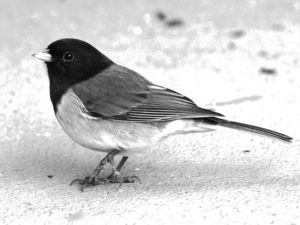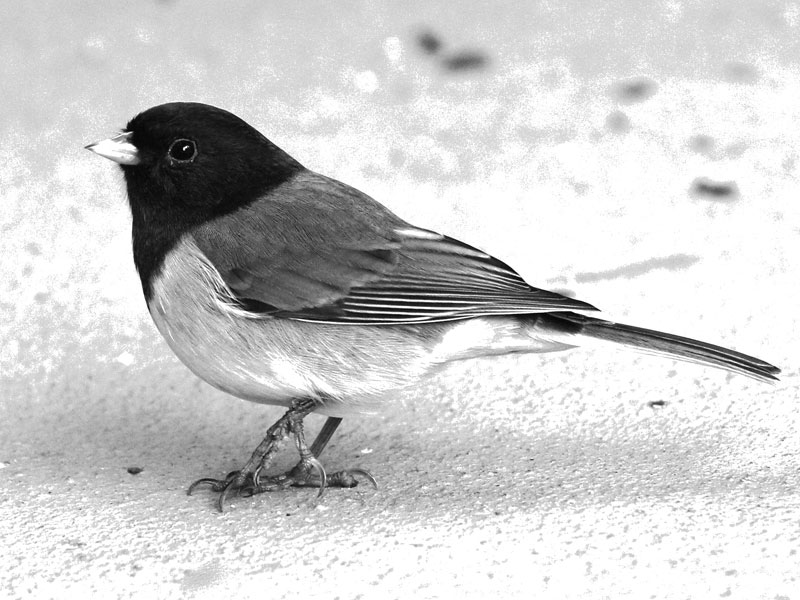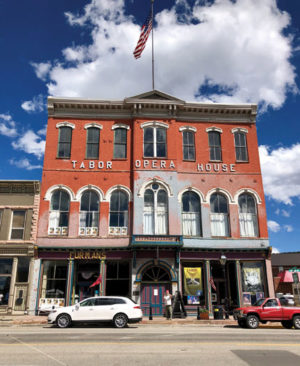By Tina Mitchell
Common and conspicuous winter visitors, Dark-eyed Juncos frequent Colorado’s seed feeders and rural roadsides. John Jay Audubon once referred to the junco as “the little Snowbird,” since in many places it showed up only in the winter. This junco’s scientific name – Junco hyemalis – as well as its common name derive in part from Latin juncus, meaning “reed” since it (sort of) resembles Europe’s Reed Bunting. The species name hyemalis translates to “of or belonging to winter,” because also in Sweden (home of Carl Linnaeus, who named the bird), juncos appeared only in the winter. “Dark-eyed” differentiates these birds from Yellow-eyed Juncos, which occasionally wander from Mexico into extreme southeastern Arizona.
 A junco can be identified by its pink bill and white tail edgings that flash brightly as it flies away. A long-tailed, small-bodied sparrow, it usually sports a dark “hood” (head, throat, nape) that makes the pink bill easy to spot and a dark back, both contrasting sharply with a white chest and belly. I say “usually” because this species exhibits greater plumage variation than any other bird species in the U.S. In fact, the species encompasses up to seven subspecies, some of which were once considered full species themselves. My records covering 20 years show that the only month our feeders in Fremont County didn’t attract at least one junco was July. However, the numbers – and variety – peak between October and March.
A junco can be identified by its pink bill and white tail edgings that flash brightly as it flies away. A long-tailed, small-bodied sparrow, it usually sports a dark “hood” (head, throat, nape) that makes the pink bill easy to spot and a dark back, both contrasting sharply with a white chest and belly. I say “usually” because this species exhibits greater plumage variation than any other bird species in the U.S. In fact, the species encompasses up to seven subspecies, some of which were once considered full species themselves. My records covering 20 years show that the only month our feeders in Fremont County didn’t attract at least one junco was July. However, the numbers – and variety – peak between October and March.
The most common junco in central Colorado is the gray-headed subspecies (also referred to as a “form”), with gray sides and a brown patch high on its gray back. This subspecies, the only one to summer in the state, breeds in the high-country forests of Colorado. The Oregon subspecies has a dark gray or black hood (males) or dark brown hood (females) with pinkish-brown sides and a gray back. Some consider the pink-sided form simply a pale variant of the Oregon subspecies; others classify it as a separate subspecies. It can indeed be a challenge to differentiate pink-sideds from Oregons. Look to see how dark their heads are compared to their black eyes. If the head is so dark that you can’t distinctly see the eyes, it’s probably – PROBABLY – an Oregon. If the eyes are darker than the rest of the head, pink-sided becomes a good guess.
[InContentAdTwo]
The other subspecies occur less often in Colorado, although they are among the most stunning. The red-backed form looks like a gray-headed except that the brown patch on its back shows a reddish-brown cast, resembling a dark-eyed version of the Yellow-eyed Junco. The slate-colored junco has a uniformly dark gray head and back, with the gray stretching to the chest as well. The Cassiar form has a darker gray hood contrasting sharply with a paler gray back washed with a touch of brown. (Some don’t consider Cassiar a subspecies but rather a cross between slate-colored and Oregon subspecies.) The white-winged junco looks like a light version of a slate-colored, except that you can see white wing bars (short strips of white about mid-wing). Just to keep things dicey, though, slate-coloreds can exhibit hints of white wing bars too.
This species has still not been completely untangled. As a final straw to the taxonomic chaos, the subspecies can hybridize, resulting in vast variations on the junco “theme.” Thank goodness they have all been lumped into the super-species of Dark-eyed Junco, at least for now; only the truly obsessed need to worry about all of the details. The rest of us can just sit back and enjoy their perky presence and eye-catching plumage variability. Regardless of the subspecies, one of a male junco’s most appreciated characteristics (at least by me) is his propensity to set his lovely, rapid, bell-like trill ringing through the late winter air on a sunny day.
As you drive along a rural road in winter, check any group of small dark birds flying from the road’s edge. When surprised, a junco flock explodes into a twittering, scattering cloud like leaves whipped around in a wind gust. Their bright white outer tail feathers flash conspicuously but disappear as soon as birds land. That fleeting glimpse of white tells you that you’ve likely just startled a group of Audubon’s “snowbirds.”
After 25 years of watching the natural world in Colorado, Tina now watches it in San Diego County, California. There she works to protect her tiny corner of the planet through wildlife rehabilitation and outdoor education with elementary school kids – two load-bearing columns of Nature’s future.
The Natural World is generously sponsored by Ann and Henry Klaiman.


